Truck classification
Truck classifications are typically based upon the maximum loaded weight of the truck, typically using the gross vehicle weight rating (GVWR) and sometimes also the gross trailer weight rating (GTWR), and can vary among jurisdictions.
United States[]
In the United States, commercial truck classification is determined based on the vehicle's gross vehicle weight rating (GVWR). The classes range from 1–8.[1][2] Trucks are also classified more broadly by the Federal Highway Administration (FHWA), which groups classes 1–2 as light duty, 3–6 as medium duty, and 7–8 as heavy duty; a commercial driver's license (CDL) is generally required to operate heavy duty trucks.[1][3][4] The Environmental Protection Agency (EPA) has a separate system of emissions classifications for trucks.[1][5] The United States Census Bureau also assigned classifications in its now-discontinued Vehicle Inventory and Use Survey (VIUS) (formerly Truck Inventory and Use Survey (TIUS)).[6]
Table of US GVWR classifications[]
| US truck class | Duty classification | Weight limit [1][7] | Examples |
|---|---|---|---|
| Class 1 | Light duty | 0–6,000 pounds (0–2,722 kg) | Chevrolet Colorado/GMC Canyon, Ford Ranger, Honda Ridgeline FWD[8], Jeep Gladiator, Nissan Frontier, Toyota Tacoma |
| Class 2a | Light duty | 6,001–8,500 pounds (2,722–3,856 kg) | Chevrolet Silverado/GMC Sierra 1500, Ford F-150, Honda Ridgeline AWD[8][9][10], Ram 1500, Nissan Titan, Toyota Tundra |
| Class 2b | Light duty | 8,501–10,000 pounds (3,856–4,536 kg) | Chevrolet Silverado/GMC Sierra 2500, Ford F-250, Nissan Titan XD, Ram 2500[8][9][10] |
| Class 3 | Light duty | 10,001–14,000 pounds (4,536–6,350 kg) | Chevrolet Silverado/GMC Sierra 3500, Ford F-350, Ram 3500 |
| Class 4 | Medium duty | 14,001–16,000 pounds (6,351–7,257 kg) | Chevrolet Silverado 4500HD/International CV, Ford F-450 (chassis cab and pickup), Ram 4500[8]
Isuzu NPR-HD,[11] |
| Class 5 | Medium duty | 16,001–19,500 pounds (7,258–8,845 kg) | Chevrolet Silverado 5500HD/International CV, Ford F-550, Ram 5500
Isuzu NRR,[11] Freightliner Business Class M2 106, Kenworth T170, Peterbilt 325 |
| Class 6 | Medium duty | 19,501–26,000 pounds (8,846–11,793 kg) | Chevrolet Silverado 6500HD/International CV, Ford F-650, Freightliner Business Class M2 106, International MV[12], Kenworth T270, Peterbilt 330 |
| Class 7 | Heavy duty | 26,001–33,000 pounds (11,794–14,969 kg) | Autocar ACMD,[13] Freightliner Business Class M2 106, Ford F-750[14], Hino 338, International MV, Kenworth K370, Kenworth T370 and T440/470, Mack MD, Peterbilt 220 and 337/348 |
| Class 8 | Heavy duty | 33,001 pounds (14,969 kg) and above | Autocar ACX and DC; Volvo Truck VNL; Freightliner Cascadia, Business Class M2 112, 118SD, and EconicSD; Ford F-750; Hino XL8; International LT, HV, and RH; Kenworth T680, T880, and W990; Mack Anthem, Granite, Pinnacle, and TerraPro; Peterbilt 389,[15] 579, and 520; Western Star 4800, 4900 and 5700; Pierce, E-One, Spartan, Ferrara, KME custom fire apparatus. |
Notes on weight classes[]
"Ton" rating[]
When light-duty trucks were first produced in the United States, they were rated by their payload capacity in tons (e.g., 1⁄2-, 3⁄4- and 1-ton). Over time, payload capacities for most domestic pickup trucks have increased while the ton titles have stayed the same. The now-imprecise ton rating is presently used to compare standard sizes, rather than actual capacities.[citation needed]
This has led to categorizing trucks similarly, even if their payload capacities are different. The Chevrolet Silverado/GMC Sierra 1500, Ford F-150, Nissan Titan, Ram 1500, and Toyota Tundra are called "half-ton" pickups (1⁄2-ton). The Chevrolet Silverado/GMC Sierra 2500, Ford F-250, and Ram 2500 are called "three-quarter-ton" pickups. The Chevrolet Silverado/GMC Sierra 3500, Ford F-350, and Ram 3500 are known as "one ton" pickups.[citation needed]
Similar schemes exist for vans and SUVs (e.g. a 1-ton Dodge Van or a 1⁄2-ton GMC Suburban), medium duty trucks (e.g. the 11⁄2-ton Ford F-450) and some military vehicles, like the ubiquitous deuce-and-a-half.
Class 8[]
This section needs additional citations for verification. (December 2019) |
The Class 8 truck gross vehicle weight rating (GVWR) is a vehicle with a GVWR exceeding 33000 lb (14969 kg).[1][16] These include tractor trailer tractors, single-unit dump trucks of a GVWR over 33,000 lb, as well as non-commercial chassis fire trucks; such trucks typically have 3 or more axles. The typical 5-axle tractor-trailer combination, also called a "semi" or "18-wheeler", is a Class 8 vehicle. Standard trailers vary in length from 8' containers to 57' van trailers, with the most common length being the 53' trailer. Specialized trailers for oversized loads can be considerably longer. Commercial operation of a Class 8 vehicle in the United States requires either a Class-B CDL for non-combination vehicles, or a Class-A CDL for combination vehicles (tractor-trailers).
Canada[]
Vehicle classifications vary among provinces in Canada, due to "differences in size and weight regulations, economic activity, physical environment, and other issues".[17]: 3 While several provinces use their own classification schemes for traffic monitoring, Manitoba, Ontario, Prince Edward Island and Saskatchewan have adopted the 13-class system from the United States' Federal Highway Administration—sometimes with modifications, or in Ontario's case, for limited purposes.[17]: 3–4 [needs update] British Columbia and Ontario also distinguish between short- and long-combination trucks.[17]: 3–4 [needs update] In accident reporting, eight jurisdictions subdivide trucks by GVWR into light and heavy classes at approximately 4500 kg (9921 lb).[17]: 6
European Union and United Kingdom[]
Vehicle categories on a European driving licence include (among others) B for general motor vehicles, C for large goods vehicles, D for large passenger vehicles (buses), and are limited by the Gross Vehicle Weight Rating and number of passenger seats.
The general categories are further divided as follows:
- appending the number 1 to the licence class C or D denotes the "light" versions of said class (e.g., Minibus, or medium truck).
- appending the letter E allows for trailers of larger Gross Trailer Weight Rating (GTWR) than permitted by the standard licence category.
For the "trailer" categories, a separate driving test is generally required (e.g., "C", and "CE" require separate tests).
The classifications used on the International Driving Permit are similar to the European model.
The licence categories that deal with trucks are B and C:
- Class B permits the use of vehicles with GVWRs of not more than 3500 kg plus a trailer with GTWR not exceeding 750 kg; or, a trailer above this limit so long as the combined gross weight of car and trailer does not exceed 3500 kg (in some jurisdictions a higher combined weight limit of 4250 kg is permitted after a theoretical and practical course of seven hours, but this permission is not transferable between EU countries). Class B covers both standard passenger cars of all sizes as well as vehicles that are specifically designed for transport of goods. The latter are commonly known as light commercial vehicles (LCVs), and include vans such as the Ford Transit, Mercedes-Benz Sprinter and Fiat Ducato, as well as pickup trucks such as the Ford Ranger or Mitsubishi Triton.
- Class BE allows a trailers of up to 3500 kg GTWR to be used while driving a class B vehicle.
- Class C1 raises the GVWR limit to 7500 kg and permits a trailer with GTWR not exceeding 750 kg.
- Class C removes the GVWR limit of Class C1, but the GTWR limit for the trailer of 750 kg remains. (This often referred to as a "Rigid Heavy Goods Vehicle" or "Rigid truck" licence)
- Class C1E allows for a class B or C1 vehicle and a trailer of more than 750 kg GTWR, so long as the combined gross weight does not exceed 12000 kg.
- Class CE removes all weight limits for a Class C vehicle with trailer. (known as an "Articulated Heavy Goods Vehicle", or often simply "HGV", licence )
List of truck types[]
Truck (Lorry) See List of truck types
Gallery[]
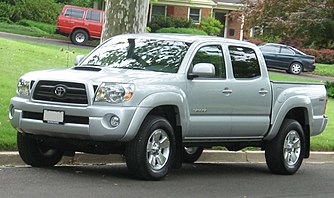
Class 1 Light duty Toyota Tacoma
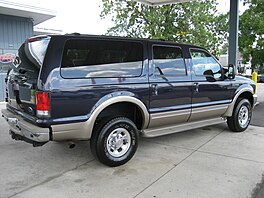
Class 2 2001 Ford Excursion 4×4 (GVWR: 8,600 pounds (3.9 t)
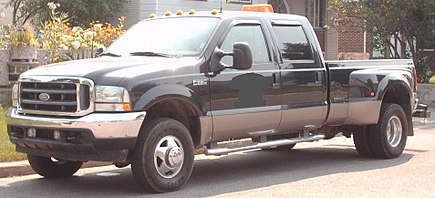
Class 3 Ford F-350
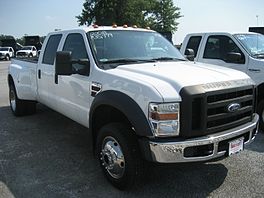
Class 4 2008 Ford F-450 4×4 pick-up truck (GVWR: 14,500 pounds (6.6 t))

Class 5 2005 Chevy Kodiak 4×4 (GVWR: 17,500 pounds (7.9 t))

Class 6 2002 Ford F-650 in front (GVWR: 26000 lb), 1989 Ford F-600 in back (GVWR: 20,200 pounds (9.2 t)
Class 7 Peterbilt 330 dump truck.
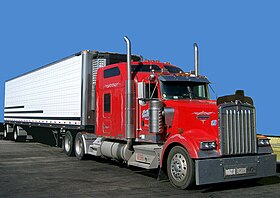
Class 8 Kenworth W900 tractor with spread-axle 48-foot (14.63 m) refrigerated trailer.

Western Star 6900XD tractor.
See also[]
- Car classification
- Corporate Average Fuel Economy (CAFE)
- Commercial vehicle
- Curb weight
- Driver's license
- Fifth wheel
- Gross weight:
- Gross axle weight rating (GAWR)
- Gross combined weight rating (GCWR)
- Gross trailer weight rating (GTWR)
- Gross vehicle weight rating (GVWR)
- Large goods vehicle
- List of truck types
- Semi-trailer
- Tow hitch
- Trailer
- Vehicle category
References[]
- ^ Jump up to: a b c d e Vehicle Weight Classes & Categories from the United States Department of Energy
- ^ NTEA.com – Gross Vehicle Weight Rating (GVWR) by Class
- ^ FHWA Vehicle Types from the United States Department of Transportation
- ^ Truck Classification, Changingears.com, March 28, 2009, retrieved April 9, 2012
- ^ Vehicle Weight Classifications from the United States Environmental Protection Agency
- ^ "Vehicle Inventory and Use Survey – Discontinued". Census.gov. June 30, 2015. Archived from the original on September 5, 2015. Retrieved August 17, 2015.
- ^ "Class 3-4-5 Truck Model Roundup". Nextexitlogistics.com. October 22, 2014. Retrieved August 17, 2015.
- ^ Jump up to: a b c d "Appendix: Truck Types and Classes" (PDF). Archived from the original (PDF) on July 22, 2011. Retrieved March 12, 2018.(archived)
- ^ Jump up to: a b "2005 Dodge Dakota Specifications, Fuel Economy & Overview". Truck Trend. February 26, 2007. Retrieved April 9, 2012.
- ^ Jump up to: a b http://www.epa.gov/otaq/climate/regulations/420b10039.pdf
- ^ Jump up to: a b c "Isuzu N-Series Diesel Trucks". www.isuzucv.com. Retrieved June 6, 2019.
- ^ GMC TopKick 4500[dead link]
- ^ "Purpose-built trucks engineered by the leading OEM dedicated to severe-duty trucks". Autocar Truck. Retrieved November 20, 2020.
- ^ Rik Hinton, Idaho Transportation Department (December 22, 2011), Idaho Commercial Driver's License Program, Itd.idaho.gov, retrieved April 9, 2012
- ^ "Model 389 | Peterbilt". www.peterbilt.com. Retrieved November 21, 2020.
- ^ "International Class 7 Crew Cab Pickup". Truck Trend. February 26, 2007. Retrieved April 9, 2012.
- ^ Jump up to: a b c d Clayton, Alan; Montufar, Jeannette; Middleton, Dan; McCauley, Bill (August 27–31, 2000), "Feasibility of a New Vehicle Classification System for Canada" (PDF), North American Travel Monitoring Exhibition and Conference (NATMEC) 2000, archived from the original (PDF) on November 1, 2004, retrieved August 9, 2013,
Furthermore, the fleet characteristics vary significantly from jurisdiction to jurisdiction across the country because of differences in size and weight regulations, economic activity, physical environment, and other issues. This has led to a wide variety of vehicle classification systems used by highway agencies and municipal authorities in their traffic monitoring programs.
External links[]
- Reducing CO2 emissions from Heavy-Duty Vehicles (European Union)
- Führerscheinklassen (Klassen der Lenkberechtigung) (in German) (trans.: Driving license classes)
- Trucks
- Vehicle law








